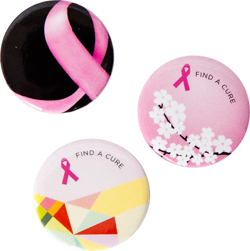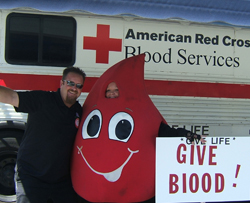HEALTH - FOCUS ON YOUR HEALTH
Year-round Awareness
for Breast Cancer & Treatment
November, 2011 - Issue #85
 |
Help Carlton Hair, located at Westfield Valencia Town Center, raise much-needed funds to find a cure for breast cancer. Stop in and purchase limited-edition pink products, including $1 Breast Cancer Awareness pins, through October; 799-9556
Stomach Fat Used to Improve
Breast Reconstruction Outcomes
Henry Mayo Hospital Offers Advanced Surgical Technique
The diagnosis wasn't any easier to take the second time around when Canyon Country resident Carolyn Atencio, who had undergone a partial breast mastectomy in 1994, learned she had breast cancer again in 2009.
"I could've had doctors just go in there and remove it, but with my high risk factor, I decided to have a bilateral mastectomy. I didn't want to risk getting cancer again," Atencio said.
Thankfully, Atencio learned that options for breast cancer patients have vastly increased over the last decade. Cutting-edge surgical procedures such as the deep inferior epigastric perforator flap, commonly referred to as breast flap reconstructive surgery, has distinct benefits over its predecessor, the transverse rectus abdominis myocutaneous (tram) flap.
The breast flap surgery uses the patient's own stomach fat tissue to reconstruct breasts following cancerous tissue removal. For patients who have had radiotherapy, the breast flap surgery is an excellent option as opposed to breast implant reconstruction.
"It's an improvement in that we're able to take a lot less of the muscle from patients and it's a quicker recovery. In four to six weeks, most patients resume their normal activities," says Peter Ashjian, MD, board certified plastic/reconstructive surgeon at Henry Mayo Newhall Memorial Hospital. "Patients really like the results, too. They don't have to have an implant. It looks and feels more natural."
Following her surgery, Atencio stayed at Henry Mayo for a total of six days, including two in the Intensive Care Unit. Follow up visits were conveniently located at the hospital's Valencia campus. Within six weeks, Atencio was up and about. She attended an Easter event in Orange County in April and participated for the first time in the Revlon Run/Walk for Breast Cancer in July. "I did 10 miles," Atencio says proudly. "I didn't think I would be able to, but I did."
Call for more information about breast imaging services at Sheila R. Veloz Breast Imaging Center, a service of Henry Mayo Hospital, or to schedule a mammogram; 253-8822 www.henrymayo.com
Make a "Beautiful" Contribution
During the month of October, 'N Style Salon contributes a portion of sales to the Susan G. Komen Foundation. Last year the company raised over $3,000. Call today to make your donation; 254-4841
Low-priced Mammograms
Available through October 31
In recognition of Breast Cancer Awareness Month, the Sheila R. Veloz Breast Imaging Center is offering women the opportunity to receive the finest in breast-imaging services for a low cash-only price. Through October, the center's cash price is $180 for a routine screening. If you or a loved one is low income without medical insurance, financial assistance may be available. Call for details; 253-8822
 |
When Comfort Keepers In-home Care prepared to host a blood drive last month they couldn't have imagined the support they received from the community. All told, 23 pints of lifesaving blood was collected. The event was so successful, in fact, that the American Red Cross will return to Comfort Keepers in February for a Valentine's Day blood drive; 287-4200
Run for the Health of It
Think about your Feet before you Run
Wearing shoes that are too tight is the leading cause of bunions. Bunions are not hereditary, but they do tend to run in families, usually because of a faulty foot structure. Foot injuries, neuromuscular problems, flat fee, and pronated feet can contribute to their formation. It is estimated that bunions occur in 33 percent of the population in Western countries. Because they are bone deformities, bunions do not resolve by themselves. Contact a podiatrist to learn about ways to treat bunions and manage pain. Dr. Robert J. Abrams of the Foot Care Center of Santa Clarita; 253-3668
Staying Fit when the Weather Keeps You Inside
Surveys have shown that up to 30 percent of people get no exercise during the winter. That figure is undoubtedly lower in our mild Southern California climate, but there is no reason to put physical fitness on hold until the weather improves. Consider taking cycling classes to help keep the pounds off, get a head start on swimsuit season, and avoid losing strength and stamina. A 50-minute cycling workout can burn up to 700 calories, as well as tone lower-body muscles. There is no impact on your joints and no special techniques to learn. Motivating music and knowledgeable instructors ensure that your experience is fun, safe and energizing. You'll work up a sweat, release endorphins, and feel better about eating that piece of pumpkin pie! Debbie Childs of Spokes Indoor Cycling; 291-1196 www.spokesindoorcycling.com
Low Back Pain: What Can You Do?
If you are considering medications to relieve your pain - especially chronic back pain - it's also important to consider their risks and side effects.
Over-the-Counter Pain Relievers
Nonsteroidal anti-inflammatory drugs (NSAIDs) - including aspirin, Aleve, Advil and Motrin - are among the most commonly used pain relievers. Side effects most commonly occur if you are take large doses over a long period of time, such as stomach pain, bleeding and/or stomach ulcers. Also, if you have heart disease, you increase your risk of heart attack or stroke by taking NSAIDs for a long time.
Opioid Pain Medications
Narcotic (or opioid) pain medicines work by blocking the transmission of pain messages to the brain. Examples of these are: codeine, Percocet, OxyContin, Vicodin, Lortab and morphine. These powerful pain relievers can help relieve severe lower back pain, but they are intended to be used only for a short period. Narcotic drugs should only be used under a doctor's supervision because they can cause physical dependence and addiction, as well as drowsiness.
Muscle Relaxants
Muscle relaxants, such as Valium or Flexeril, act on the central nervous system to relieve painful muscle strains and spasms. However, these drugs are not recommended for long-term use (more than two weeks) because they become less effective over time and can be habit forming.
Antidepressants
Some drugs usually prescribed to treat depression have also been shown to help relieve chronic lower back pain, and doctors sometimes prescribe these medications to alleviate pain. Cymbalta has been approved for chronic musculoskeletal pain such as osteoarthritis and chronic low back pain. Also, low doses of tricyclic antidepressants such as Elavil and Norpramin have been studied most often for back pain; however, these drugs also have side effects like drowsiness, dizziness, dry mouth and appetite loss.
Injections
If oral medications aren't enough to relieve your lower back pain, your doctor may suggest injecting a steroid medication into the space around your spinal cord to bring down inflammation and provide short-term pain relief. However, injections can weaken the immune system when used long term and they can increase risk of infection.
Dr. Devinder S. Kumar, MD of Ultimate Pain Management; 257-7500
|
||||||||||||||||||||||||||||




